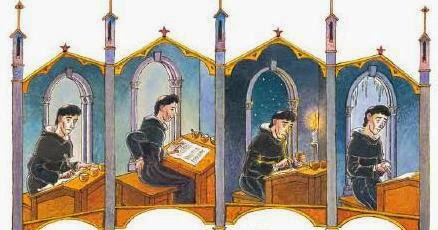For Valentine's Day this year, I gifted each of my children a "one free book" coupon and they got to select ANY book they wanted to have shipped to them (all second hand "Like New" copies, to keep it cost effective and I retained veto powers of course...) With just a hint of guidance, my three year old saw the picture of Brother Hugo and the Bear and declared proudly that it was to be his choice. Yes!
The book came and immediately I fell in love with it. It is a story imagined by Katy Beebe from one tiny little line in a real, historical letter that comments this:
"And send to us, if you please, the great volume of letters by the holy father Augustine, which contains his letters to Saint Jerome, and Saint Jerome's to him. For it happens that the greater part of our volume was eaten by a bear."
The book is not Catholic per se. But it is decidedly real and fresh in the dealings with 100% of the characters being monks (except the bear) and the work they do being authentic to that time period. It opens up, fittingly on Lent as poor Brother Hugo has to recopy the entire manuscript he lost... which makes for a proper seasonal penance. Illustrations are exceptionally well done by Steve Schindler for the book and the illuminated lettering mimics the style (in a nouveaux way) of the medieval masters.
 The book would be a great unit study builder for all things medieval... especially cloistered life, illuminated letters, manuscript making and the 12th century in general. I am going to pair it with a viewing of that oddly strange and beautiful period movie: The Secret of Kells. If I was really motivated, I'd figure out some sort of illuminated letter lesson but I'm pretty sure all our markers are currently lost in heater return vents or chewed up by the puppy. So that may need to wait...
The book would be a great unit study builder for all things medieval... especially cloistered life, illuminated letters, manuscript making and the 12th century in general. I am going to pair it with a viewing of that oddly strange and beautiful period movie: The Secret of Kells. If I was really motivated, I'd figure out some sort of illuminated letter lesson but I'm pretty sure all our markers are currently lost in heater return vents or chewed up by the puppy. So that may need to wait... All in all, I'm delighted to have this book and use it as Lenten reading (not in a pious way, but at least in a relevant, fun way) and highly recommend it to those who are interested in bringing the Middle Aged, monastic life alive for their children. Probably my best picture book purchase in a long time...
Check out this hypnotic video showing the start to finish illustrations, set to chant...




